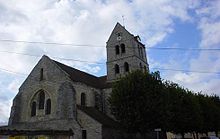We bicycled yesterday through Montigny, Grez, Villiers-sous-Grez, Larchant and Nemours.
In the area of Fontainbleau, Ile-de-France, south of Paris.
And I exhausted myself in pushing Marguerite about ten miles altogether against a head wind. We had tea at Villiers, just a straggling village without any attraction except that of its own life. During our meal the drone of a steam thresher was heard rising and falling continually.
 |
| St Etienne, Villiers-sous-Grez |
Everything was beaten by wind and sunshine. From the inside of the little inn came hoarse argumentative voices. Curious to see in this extremely unsophisticated village a Parisian cocotte of the lower ranks. She was apparently staying at the inn. With her dog, and her dyed hair (too well arranged), and her short skirt, and her matinee (at 4.30 pm), and her hard eyes, she could not keep from exhibiting herself in the road. The instinct of 'exposition' was too strong in her to be resisted. She found fifty excuses for popping into the house and out again.
Then we road through woods five kilometres to Larchant. You know that the cathedral at Larchant is a show-place because the post cards are two sous each.
Although partly ruined, the church St., Machurin still presents an imposing aspect. The church started to rise in second half of the 12th century, a little
after Notre-Dame of Paris and, in 1176, the choir and the transept were
to be mainly completed since one transferred the "reliquary" from
Saint.-Mathurin.
It is probable that the same architects and the same " tailors of images " worked in Notre-Dame and Saint-Mathurin.
In the second quarter of the 13th century, work of the church was
already rather advanced (construction of the nave), when one made the
decision to add a tower to the primitive plan, intended to be used of
porch and bell-tower. This tower, high, 50 meters is distinguished in the neighbourhoods and
it is by it that the church of Larchant enjoys with far from a precisely
deserved reputation. Later, at the end of 13th and the 14th century, one built each side of
the chorus, a vault, with north, and a sacristy and a treasure in the
south. The vault, dedicated to the Virgin, is a true jewel of ogival architecture. But few religious buildings had to undergo the insults of the men and
the devastations of the natural disasters, like the church of Larchant. In 1827, the ruined tower was sold to a manufacturer like stone quarry. But the market was cancelled because of the difficulty of work: in spite
of its state of decay, the church still resisted the pickaxes of the
demolition contracters. In 1843, the church Saint- Mathurin was classified "Historic monument".
 |
| Ruins of cathedral church at Larchant |
Frederick Marriott, R.E., R.B.C, A.R.C.A. was born on 20th
October 1860 at Stoke-on-Trent, England, brother of the artist Frank
Pickford Marriott. He received his early training in the school of Art,
Coalbrookdale, and at the age of 14 went to work as a pottery painter in
a factory. In 1879 he gained a National Scholarship at the R.C.A. where
he studied for three years.
Marriott then worked as a designer and illustrator to Marcus Wood and Company. He later became Chief Designer with Eyre and Spottiswood, and remained for four and a half years. He practised repoussé work, wood carving, enamelling and modelling, and produced some fine panels in modelled gesso with mother-of-pearl inlay.Marriott exhibited at the R.A., R.E., in the provinces and at the Paris Salon. He was Design Master at Blackheath Art School, Headmaster of the Onslow College Art School, Chelsea, and Headmaster, Goldsmith's Institute, 1895-1925. He was a member of the Arts and Crafts Society, also the Art Workers' Guild, and was elected A.R.E. 1909, R.E. 1924. Made continental tours working on town scenes with the emphasis on architecture, and also visited and painted in Australia about 1910.
He was an associate of Brangwyn, Clausen, Drury and East. Marriott Lived in London and died on October 2nd, 1941.
Marriott then worked as a designer and illustrator to Marcus Wood and Company. He later became Chief Designer with Eyre and Spottiswood, and remained for four and a half years. He practised repoussé work, wood carving, enamelling and modelling, and produced some fine panels in modelled gesso with mother-of-pearl inlay.Marriott exhibited at the R.A., R.E., in the provinces and at the Paris Salon. He was Design Master at Blackheath Art School, Headmaster of the Onslow College Art School, Chelsea, and Headmaster, Goldsmith's Institute, 1895-1925. He was a member of the Arts and Crafts Society, also the Art Workers' Guild, and was elected A.R.E. 1909, R.E. 1924. Made continental tours working on town scenes with the emphasis on architecture, and also visited and painted in Australia about 1910.
He was an associate of Brangwyn, Clausen, Drury and East. Marriott Lived in London and died on October 2nd, 1941.
 |
| Me at Les Sablons by F Marriott |

No comments:
Post a Comment